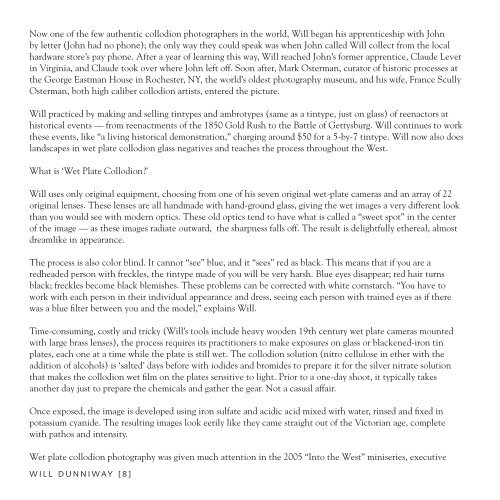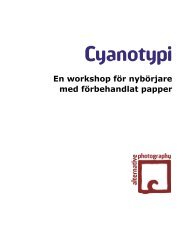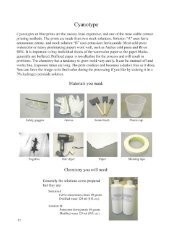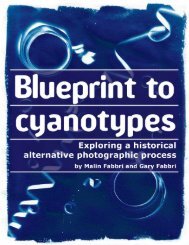WILL DUNNIWAY Collodion Photographer - AlternativePhotography ...
WILL DUNNIWAY Collodion Photographer - AlternativePhotography ...
WILL DUNNIWAY Collodion Photographer - AlternativePhotography ...
Create successful ePaper yourself
Turn your PDF publications into a flip-book with our unique Google optimized e-Paper software.
Now one of the few authentic collodion photographers in the world, Will began his apprenticeship with John<br />
by letter (John had no phone); the only way they could speak was when John called Will collect from the local<br />
hardware store’s pay phone. After a year of learning this way, Will reached John’s former apprentice, Claude Levet<br />
in Virginia, and Claude took over where John left off. Soon after, Mark Osterman, curator of historic processes at<br />
the George Eastman House in Rochester, NY, the world’s oldest photography museum, and his wife, France Scully<br />
Osterman, both high caliber collodion artists, entered the picture.<br />
Will practiced by making and selling tintypes and ambrotypes (same as a tintype, just on glass) of reenactors at<br />
historical events — from reenactments of the 1850 Gold Rush to the Battle of Gettysburg. Will continues to work<br />
these events, like “a living historical demonstration,” charging around $50 for a 5-by-7 tintype. Will now also does<br />
landscapes in wet plate collodion glass negatives and teaches the process throughout the West.<br />
What is ‘Wet Plate <strong>Collodion</strong>?’<br />
Will uses only original equipment, choosing from one of his seven original wet-plate cameras and an array of 22<br />
original lenses. These lenses are all handmade with hand-ground glass, giving the wet images a very different look<br />
than you would see with modern optics. These old optics tend to have what is called a “sweet spot” in the center<br />
of the image — as these images radiate outward, the sharpness falls off. The result is delightfully ethereal, almost<br />
dreamlike in appearance.<br />
The process is also color blind. It cannot “see” blue, and it “sees” red as black. This means that if you are a<br />
redheaded person with freckles, the tintype made of you will be very harsh. Blue eyes disappear; red hair turns<br />
black; freckles become black blemishes. These problems can be corrected with white cornstarch. “You have to<br />
work with each person in their individual appearance and dress, seeing each person with trained eyes as if there<br />
was a blue filter between you and the model,” explains Will.<br />
Time-consuming, costly and tricky (Will’s tools include heavy wooden 19th century wet plate cameras mounted<br />
with large brass lenses), the process requires its practitioners to make exposures on glass or blackened-iron tin<br />
plates, each one at a time while the plate is still wet. The collodion solution (nitro cellulose in ether with the<br />
addition of alcohols) is ‘salted’ days before with iodides and bromides to prepare it for the silver nitrate solution<br />
that makes the collodion wet film on the plates sensitive to light. Prior to a one-day shoot, it typically takes<br />
another day just to prepare the chemicals and gather the gear. Not a casual affair.<br />
Once exposed, the image is developed using iron sulfate and acidic acid mixed with water, rinsed and fixed in<br />
potassium cyanide. The resulting images look eerily like they came straight out of the Victorian age, complete<br />
with pathos and intensity.<br />
Wet plate collodion photography was given much attention in the 2005 “Into the West” miniseries, executive<br />
W I L L D U N N I W A Y [ 8 ]






